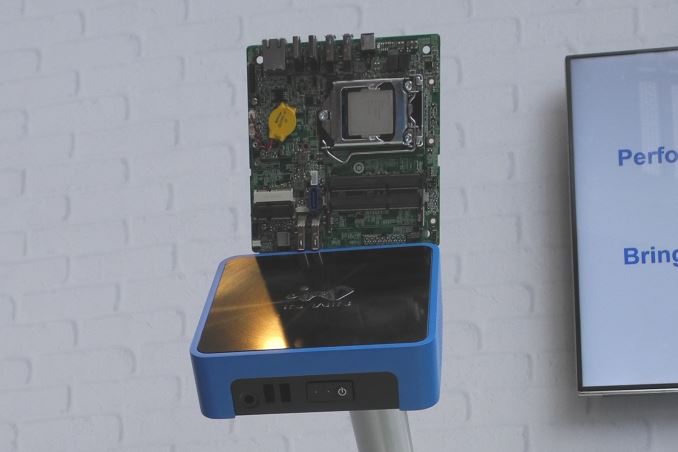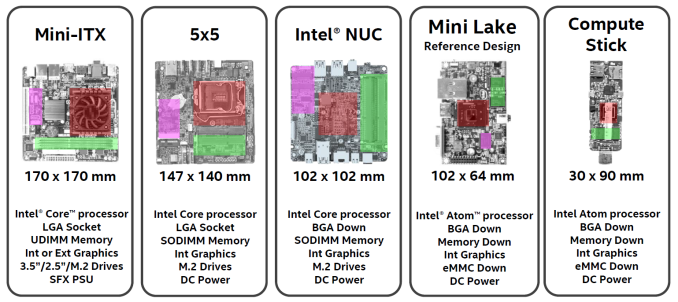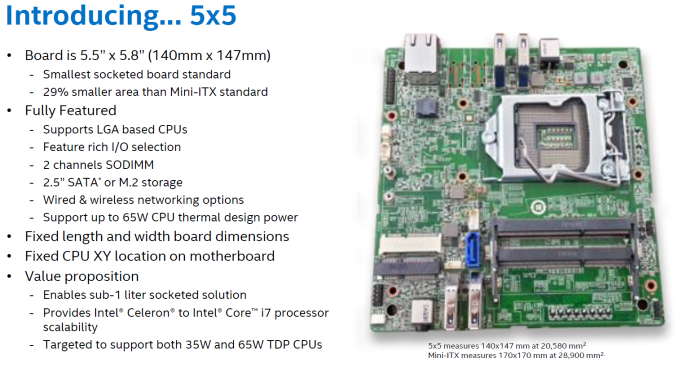Intel Launches New Socketed 5x5 mini-PC Motherboards
by Ganesh T S on August 24, 2015 4:35 AM EST- Posted in
- Trade Shows
- Systems
- Intel
- Motherboards
- Mini-PC
- IDF 2015
- 5x5

Over the last couple of years, the ultra-compact form factor (UCFF) has emerged as one of the bright spots in the troubled PC market. Kickstarted by Intel's NUC (Next Unit of Computing) designs, it has been successfully cloned by other vendors such as GIGABYTE (BRIX), Zotac (C-series nano) and ASRock (Beebox). With platform performance increasing every generation, and performance requirements getting tempered by the rise of the not-so-powerful smartphones and tablets, Intel could pack a heavy punch with their 102x102mm NUC motherboards.
Atom-based units (using Bay Trail) could provide very good performance for most users. Intel tried to shrink the PC even further by releasing a Compute Stick based on the Bay Trail Atom Z series SoCs earlier this year. ECS, with their LIVA designs, has adopted the Mini Lake reference design for their UCFF PCs. All of these UCFF PCs come with BGA CPUs / SoCs. The configurability aspect is minimal from an end-user's perspective. Looking at the mini-ITX form factor immediately leads us to a hole in the mini-PC lineup between it and the NUC.
At IDF last week, Intel quietly launched the new 5x5 motherboard form factor. Coming in at 147x140mm, it is closer to the NUC in the fact that it can operate directly off DC power and takes SODIMM memory. Approaching from the mini-ITX side gives us the LGA socket for a Core processor. Unfortunately, at this size, we have to make do without the full length PCIe slot.
Intel suggests that solutions using the 5x5 boards could come in with a 39mm height for a volume of 0.89L (when using M.2 drives and a heat sink suitable for 35W TDP CPUs). 65W TDP CPUs and 2.5" drive support would obviously increase the height requirements.
Many usage areas which required custom-sized embedded boards (such as digital signage / point of sale terminals / kiosks etc.) have now opened up for the PC, thanks to the NUC and other similar form factors that were introduced over the last year or so. The new 5x5 form factor ensures that a mini-PC is available for every size and performance requirement. As of now, it looks like In-Win has a chassis design ready for the new form factor. We are awaiting more information on the board(s) and availability details.












44 Comments
View All Comments
Morawka - Monday, August 24, 2015 - link
this is obviously gonna help sell those iris pro sku's and edram sku's with 72 EU's. pretty neat but i thought intel was trying to move away from socket-able cpu's.socket cpu's tend to produce more heat as well.. i can see some newbie putting a 6770k in a chassis that's meant for 35w.
this will however allow more customization options in the oem space.
ddriver - Monday, August 24, 2015 - link
There is nothing about a socket that could result in more heat. It is merely that soldered CPUs are primarily low power derivatives. You can use a socket for a milliwatt chip and you can solder a 100W chip, but this is rarely done because it is usually not commercially viable.mrdude - Monday, August 24, 2015 - link
It's about z-height and cost :)These look nifty. It's just too bad Intel overcharges on the chips suitable for these sorts of applications (eg., Steam Machines). And I'm assuming the 65W limit has to do with the power delivery and not the cooling? That looks like a standard 1150 socket, meaning compatibility with aftermarket coolers galore.
Yuriman - Monday, August 24, 2015 - link
Look at the mounting holes - definitely won't take existing coolers.DanNeely - Tuesday, August 25, 2015 - link
According to Arstechnica, the intent is for the cooler to be built into the case chassis itself.Samus - Wednesday, August 26, 2015 - link
At 30% smaller, that might sound like a lot, but it really isn't much smaller than ITX and the sacrifices are substantial for those extra millimeters.Considering they ditched the 24+4 ATX power connector AND full-length DIMM sockets, there
would be plenty of room on the board for at least a 4x PCIe slot.
I think it would make more sense to introduce a smaller socketable package than a whole new motherboard format, like AMD did with the AM1. After all, the die size is a fraction of the package size, just tweak the package and shrink it down, there is a lot of dead space in the center of LGA CPU's.
eanazag - Monday, August 24, 2015 - link
Intel is not trying to move away from money. This is definitely trying to give a home those Broadwell Iris CPUs.Valantar - Monday, August 24, 2015 - link
I have to say I'm intrigued by this - the combination of compact form factors and modularity is very appealing. Now just combine this with Thunderbolt 3 and a reference platform/design for matching external "slice" GPU chassis, and you'd have an excellent upgradeable and expandable platform. SODIMM memory has been available with decent performance for quite a while, so this is a nice turn of events.bernstein - Monday, August 24, 2015 - link
clearly this has to be intels designated successor to thin-mITX. its a bit smaller (170x170 vs 140x147) plus it removes the lone PCIEx1 slot which never made sense.nightbringer57 - Monday, August 24, 2015 - link
It does make sense. It's not always a pci-e 1x slot, it's often a full pci-e 16x slot.You can make a pretty nice and compact gaming machine based on mini itx, it won't be possible with this one until we can finally get external GPUs straight.
Of course if you don't care about gaming or don't have needs for an internal pcie slot it does not make sense.
But there are a few advantages that I would gladly take from the 5x5 platform on mini ITX mainboards. Especially the fixed position CPU socket. This would be so helpful for cooler compatibility issues...